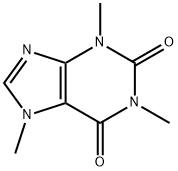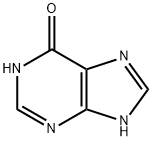HPLC>98% , 58-08-2
Synonym(s):
1,3,7-Trimethylxanthine;Caffeine
CAS NO.:58-08-2
Empirical Formula: C8H10N4O2
Molecular Weight: 194.19
MDL number: MFCD00005758
EINECS: 200-362-1
PRODUCT Properties
| Melting point: | 234-236.5 °C(lit.) |
| Boiling point: | 178°C |
| Density | 1.23 |
| vapor pressure | 20 hPa ( 80 °C) |
| FEMA | 2224 | CAFFEINE |
| refractive index | 1.6590 (estimate) |
| Flash point: | 178°C |
| storage temp. | 2-8°C |
| solubility | Sparingly soluble in water, freely soluble in boiling water, slightly soluble in ethanol (96 per cent). It dissolves in concentrated solutions of alkali benzoates or salicylates. |
| pka | pKa 0.6 (Uncertain) |
| form | Crystals or Crystalline Powder |
| color | Silky white or white |
| Odor | at 100.00 %. odorless |
| PH | pH (10g/l, 25℃) : 5.5~6.5 |
| Odor Type | odorless |
| Water Solubility | 20 g/L (20 ºC) |
| Sublimation | 178 ºC |
| Merck | 14,1636 |
| BRN | 17705 |
| Stability: | Stable. Incompatible with strong acids, strong bases, strong oxidizing agents, iodine, silver salts, tannins. Weakly light sensitive in solution. |
| Cosmetics Ingredients Functions | FRAGRANCE SKIN CONDITIONING PERFUMING |
| LogP | -0.07 |
| CAS DataBase Reference | 58-08-2(CAS DataBase Reference) |
| IARC | 3 (Vol. 51) 1991 |
| NIST Chemistry Reference | Caffeine(58-08-2) |
| EPA Substance Registry System | Caffeine (58-08-2) |
Description and Uses
Caffeine is a purine alkaloid commonly found in coffee and tea. Several in vivo studies have demonstrated that topical and oral administration of caffeine exerts a photoprotective effect through various mechanisms. Specifically, caffeine has been demonstrated to induce apoptosis in DNA damaged epidermal cells and tumors while sparing normal tissue. Mouse models demonstrate that this apoptotic effect is secondary to increased expression of wild-type p53, a tumor suppressor gene that is commonly mutated in UV-related skin cancers. Moreover, caffeine also has a sunscreen-like effect and inhibits formation of UVB-induced thymine dimers and sunburn skin lesions.
Caffeine is a bitter, white crystalline xanthine alkaloid that acts as a stimulant drug and a reversible acetylcholinesterase inhibitor. Caffeine is found in varying quantities in the seeds, leaves, and fruit of some plants, where it acts as a natural pesticide that paralyzes and kills certain insects feeding on the plants. In humans, caffeine acts as a central nervous system stimulant, temporarily warding off drowsiness and restoring alertness. Caffeine is a cardiac and respiratory stimulant; diuretic. Caffeine is toxic at sufficiently high doses.
Safety
| Symbol(GHS) |  GHS07 |
| Signal word | Warning |
| Hazard statements | H302 |
| Precautionary statements | P301+P312+P330 |
| Hazard Codes | Xn,T,F |
| Risk Statements | 22-25-39/23/24/25-23/24/25-11 |
| Safety Statements | 16-36/37-45-7 |
| RIDADR | UN 1544 6.1/PG 3 |
| WGK Germany | 1 |
| RTECS | EV6475000 |
| F | 10 |
| Autoignition Temperature | >600°C |
| TSCA | Yes |
| HazardClass | 6.1 |
| PackingGroup | III |
| HS Code | 29393000 |
| Hazardous Substances Data | 58-08-2(Hazardous Substances Data) |
| Toxicity | LD50 orally in mice, hamsters, rats, rabbits (mg/kg): 127, 230, 355, 246 (males); 137, 249, 247, 224 (females) (Palm) |




